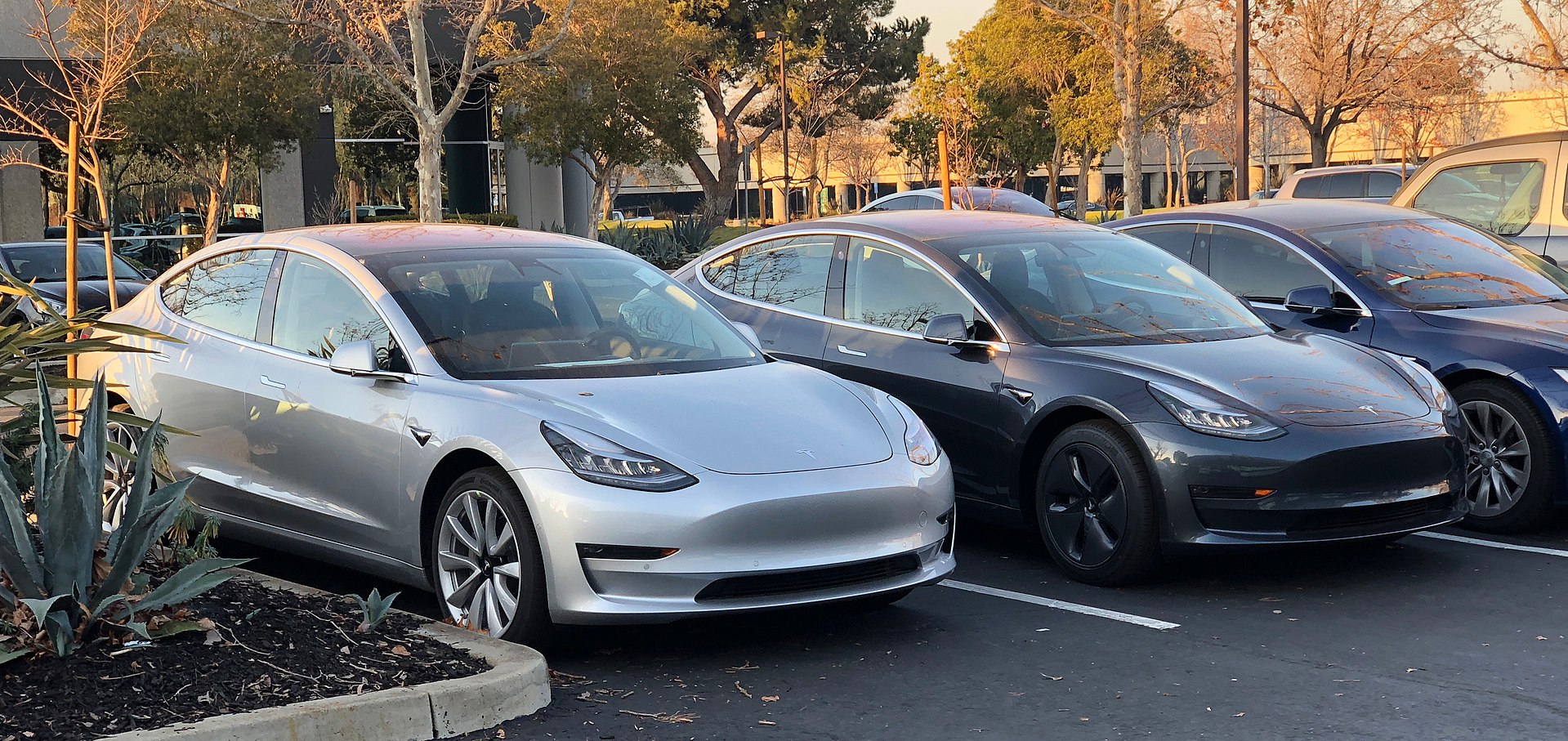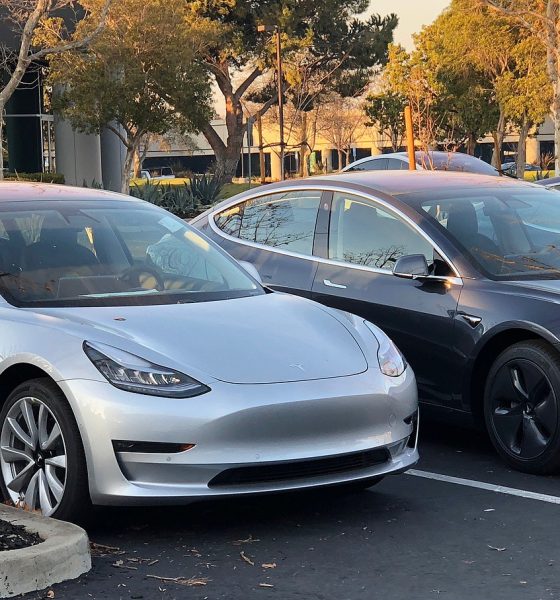

News
Tesla’s Model 3 and the death of plug-in hybrids: ‘Full electric is a much more elegant solution’
Tesla took a big bet when it decided to launch the Model 3. Being a vehicle designed for the mass market, the sheer scale of the sedan’s production was something that Tesla has not dealt with before. It took more time than expected and a trip through “production hell,” but the Model 3 has now been ramped, with Elon Musk noting that producing 5,000 of the vehicles per week is currently no big deal for Tesla.
The market’s reception to the Model 3 has been encouraging. The vehicle has been performing well in the United States, ranking among America’s best-selling passenger cars. In September alone, the Model 3 became the 4th best-selling car in the US based on sales volume. Based on revenue, the Model 3 was even more impressive, ranking first among passenger cars sold in the country. Tesla does not seem to be planning on pulling back from its Model 3 push either, as the electric carmaker has started rolling out exhibits of the vehicle to Europe and Asia this month.
Amidst the evident success of the Model 3 and Elon Musk’s high-stakes bet on the electric sedan, another class of vehicles has begun to show notable signs of a decline — the plug-in hybrids. Plug-in hybrid electric vehicles (PHEV) are equipped with both an electric motor and an internal combustion engine. Popular cars in this class include the Chevy Volt, with its all-electric range of up to 53 miles, and a total range of 420 miles with a full battery and a full tank of gas.

PHEVs have mostly served as the “gateway” vehicles for customers looking to make the jump to electric transportation. Being equipped with a gasoline engine, owners need not worry about any of the initial drawbacks of pure EVs, such as limited range. Plug-in Hybrid and Electric Vehicle Research Center director Gil Tal noted to Bloomberg that in a way, PHEVs are like the “training wheels” of the electric car movement. That said, Tal noted that as practical, capable EVs like the Model 3 emerge, consumers might simply skip PHEVs and adopt all-electric cars instead.
“A full electric (car) is a much more elegant solution. It’s very simple to build and very low maintenance. It’s just a much more simple story. Plug-in hybrids are just the training wheels in the industry’s preparation for electric cars,” Tal said.
The death of plug-in hybrid electric vehicles became more real recently, with GM announcing that it was closing several of its plants across the United States and Canada. Among these plants was GM’s oldest factory at Detroit-Hamtramck, which produces the Volt. In a later statement, GM confirmed that it would be discontinuing the production of the Volt, with the company focusing on developing all-electric cars like the Bolt EV instead.

GM has announced that it is discontinuing the production of the Chevy Volt. [Credit: Chevrolet]
In a way, the apparent death of the PHEV seemed to have been predicted by Elon Musk eight years ago. In a statement to the media during the opening ceremony of the Fremont factory, Musk likened PHEVs to amphibians during the process of evolution. And just like amphibians, Musk noted that the number of PHEVs would likely decrease as the market moves into the full-electric era.
“(PHEVs are) similar to an amphibian. In the transition from the oceans to land, initially, there were a lot of amphibians. Now there’s not that many amphibians. So the only reason you’d ever need that gasoline engine is if the battery pack does not have enough range, if the recharge times are really slow, and all those things will get solved. So there’s a medium-term role for a plug-in hybrid, but in our view, not a long-term role. I think there’s a role for plug-in hybrids today and there’s a role for electrics, but I think long-term, it all goes electric.”
The seemingly impending death of the plug-in hybrid is not just the result of electric cars like Tesla’s Model S, 3, and X. Earlier this year, a Forbes report earlier this year noted that the efforts (or lack thereof) of manufacturers such as GM are partly to blame for the decline of PHEVs. Inasmuch as the Volt was warmly received by owners and well-reviewed by critics, for example, the vehicle remained a rare sight among GM’s dealerships across the United States. GM’s TV advertising campaigns have not featured the Volt, or its all-electric sibling, the Bolt EV, either.
That said, GM appears to be taking its EV initiative seriously this time around. Earlier this month, for one, VP of global strategy Mike Ableson boldly declared during a press conference that GM is looking to “lead the industry in EVs sometime in the next decade or so.” The next years will determine if these words will be true.

News
Tesla FSD fleet is nearing 7 billion total miles, including 2.5 billion city miles
As can be seen on Tesla’s official FSD webpage, vehicles equipped with the system have now navigated over 6.99 billion miles.

Tesla’s Full Self-Driving (Supervised) fleet is closing in on almost 7 billion total miles driven, as per data posted by the company on its official FSD webpage.
These figures hint at the massive scale of data fueling Tesla’s rapid FSD improvements, which have been quite notable as of late.
FSD mileage milestones
As can be seen on Tesla’s official FSD webpage, vehicles equipped with the system have now navigated over 6.99 billion miles. Tesla owner and avid FSD tester Whole Mars Catalog also shared a screenshot indicating that from the nearly 7 billion miles traveled by the FSD fleet, more than 2.5 billion miles were driven inside cities.
City miles are particularly valuable for complex urban scenarios like unprotected turns, pedestrian interactions, and traffic lights. This is also the difference-maker for FSD, as only complex solutions, such as Waymo’s self-driving taxis, operate similarly on inner-city streets. And even then, incidents such as the San Francisco blackouts have proven challenging for sensor-rich vehicles like Waymos.
Tesla’s data edge
Tesla has a number of advantages in the autonomous vehicle sector, one of which is the size of its fleet and the number of vehicles training FSD on real-world roads. Tesla’s nearly 7 billion FSD miles then allow the company to roll out updates that make its vehicles behave like they are being driven by experienced drivers, even if they are operating on their own.
So notable are Tesla’s improvements to FSD that NVIDIA Director of Robotics Jim Fan, after experiencing FSD v14, noted that the system is the first AI that passes what he described as a “Physical Turing Test.”
“Despite knowing exactly how robot learning works, I still find it magical watching the steering wheel turn by itself. First it feels surreal, next it becomes routine. Then, like the smartphone, taking it away actively hurts. This is how humanity gets rewired and glued to god-like technologies,” Fan wrote in a post on X.
News
Tesla starts showing how FSD will change lives in Europe
Local officials tested the system on narrow country roads and were impressed by FSD’s smooth, human-like driving, with some calling the service a game-changer for everyday life in areas that are far from urban centers.

Tesla has launched Europe’s first public shuttle service using Full Self-Driving (Supervised) in the rural Eifelkreis Bitburg-Prüm region of Germany, demonstrating how the technology can restore independence and mobility for people who struggle with limited transport options.
Local officials tested the system on narrow country roads and were impressed by FSD’s smooth, human-like driving, with some calling the service a game-changer for everyday life in areas that are far from urban centers.
Officials see real impact on rural residents
Arzfeld Mayor Johannes Kuhl and District Administrator Andreas Kruppert personally tested the Tesla shuttle service. This allowed them to see just how well FSD navigated winding lanes and rural roads confidently. Kruppert said, “Autonomous driving sounds like science fiction to many, but we simply see here that it works totally well in rural regions too.” Kuhl, for his part, also noted that FSD “feels like a very experienced driver.”
The pilot complements the area’s “Citizen Bus” program, which provides on-demand rides for elderly residents who can no longer drive themselves. Tesla Europe shared a video of a demonstration of the service, highlighting how FSD gives people their freedom back, even in places where public transport is not as prevalent.
What the Ministry for Economic Affairs and Transport says
Rhineland-Palatinate’s Minister Daniela Schmitt supported the project, praising the collaboration that made this “first of its kind in Europe” possible. As per the ministry, the rural rollout for the service shows FSD’s potential beyond major cities, and it delivers tangible benefits like grocery runs, doctor visits, and social connections for isolated residents.
“Reliable and flexible mobility is especially vital in rural areas. With the launch of a shuttle service using self-driving vehicles (FSD supervised) by Tesla in the Eifelkreis Bitburg-Prüm, an innovative pilot project is now getting underway that complements local community bus services. It is the first project of its kind in Europe.
“The result is a real gain for rural mobility: greater accessibility, more flexibility and tangible benefits for everyday life. A strong signal for innovation, cooperation and future-oriented mobility beyond urban centers,” the ministry wrote in a LinkedIn post.
News
Tesla China quietly posts Robotaxi-related job listing
Tesla China is currently seeking a Low Voltage Electrical Engineer to work on circuit board design for the company’s autonomous vehicles.

Tesla has posted a new job listing in Shanghai explicitly tied to its Robotaxi program, fueling speculation that the company is preparing to launch its dedicated autonomous ride-hailing service in China.
As noted in the listing, Tesla China is currently seeking a Low Voltage Electrical Engineer to work on circuit board design for the company’s autonomous vehicles.
Robotaxi-specific role
The listing, which was shared on social media platform X by industry watcher @tslaming, suggested that Tesla China is looking to fill the role urgently. The job listing itself specifically mentions that the person hired for the role will be working on the Low Voltage Hardware team, which would design the circuit boards that would serve as the nervous system of the Robotaxi.
Key tasks for the role, as indicated in the job listing, include collaboration with PCB layout, firmware, mechanical, program management, and validation teams, among other responsibilities. The role is based in Shanghai.
China Robotaxi launch
China represents a massive potential market for robotaxis, with its dense urban centers and supportive policies in select cities. Tesla has limited permission to roll out FSD in the country, though despite this, its vehicles have been hailed as among the best in the market when it comes to autonomous features. So far, at least, it appears that China supports Tesla’s FSD and Robotaxi rollout.
This was hinted at in November, when Tesla brought the Cybercab to the 8th China International Import Expo (CIIE) in Shanghai, marking the first time that the autonomous two-seater was brought to the Asia-Pacific region. The vehicle, despite not having a release date in China, received a significant amount of interest among the event’s attendees.








